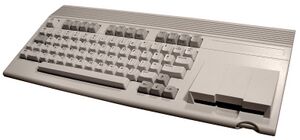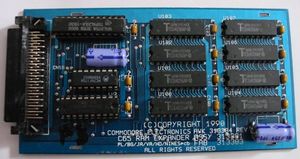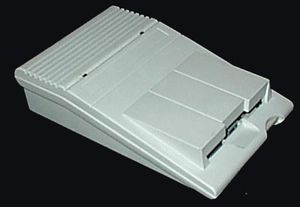C65
| C65 | |

| |
| Type: | Home and Business Computer |
| Producer: | Commodore Business Machines |
| Price: | Estimated 350 USD (1991 prices) |
| Released: | |
| Discontinued: | |
| Processor: | MOS Technology 65CE02 |
| Memory: | 128 kB expandable to 4 MB |
| OS: | BASIC V10.0, BASIC 2.2 |
| Info: | Also known as C64DX New Project: MEGA65 |
The Commodore 65 (a.k.a.: C65), also known as the C64DX, is a prototype 8-bit computer by Commodore Business Machines.
History[edit | edit source]
The first speculation about a successor to the C64 was in the beginning of 1988 and by 1989 the design of the C64DX with a built-in 3.5” floppy disk drive was underway. By 1990 the project had changed its name to C65 although the project was scrapped by the end of 1991 and therefore never reached production. Nonetheless, an unknown number of prototypes were sold in 1994 when Commodore Business Machines was liquidated.
Contributors[edit | edit source]
Fred Bowen led a team that included Paul Lassa, Bill Gardei, Victor Andrade, and Terry Fischer; as well as other contractors hired by Commodore for contributions to the DOS, graphics, audio and memory management.
Concept[edit | edit source]
The C65 was intended to be a “low-cost, versatile, competitive product designed for the international home computer and game market. Its purpose was to modernize and revitalize the 10 year old C64 market while still taking advantage of the developed base of C64 software.”
Construction[edit | edit source]
| Table 1 - Construction of the C65 | ||
|---|---|---|
| Aspect | Detail | Image |
| Dimensions | • Width: 18" (45 cm) • Depth: 8" (20 cm) • Height: 2" (5 cm) |
|
| Top Side | • 77-key Keyboard featuring: •• 8x function keys, F1 -F16 , shifted and non-shifted •• TAB , ESC , ALT , CAPS , NO SCROLL , HELP • Inverted-T cursor keys • 3.5" Floppy Disc Drive • Power and disk activity LEDs |
|
| Left Side | • Power Port +5V DC at 2.2A and +12V DC at 0.85A (4-pin DIN connector) • Power switch • Control port #2 (DE9M connector) • Control port #1 (DE9M connector) • Reset Button |
|
| Rear Side | • Fast Disk Port (8-pin mini-DIN connector) • Composite Video/Audio Port (8-pin DIN connector) • Channel Selector (RF Modulator switch) • Analog Video Port (RF Modulator connector) • RGBA Video Port (9-pin D-sub connector) • Stereo Right Port (RCA connector) • Stereo Left Port (RCA connector) • User Port (24-pin male edge connector) • Serial Port (6-pin DIN connector) • Expansion Port (50-pin female edge connector) |
|
| Bottom Side | • RAM Expansion Port (30-pin female connector) |
 |
Technical Specification[edit | edit source]
Central Processing Unit[edit | edit source]
- CSG 4510 R3 SiP containing:
- 1x MOS Technology 65CE02 running at 1.02 or 3.5 Mhz.
- 2x MOS Technology 6526 CIAs, each with 2x I/O ports, programmable TOD clocks, interval timers, and interrupt control.
- Memory Mapper supporting up to 1 MB address space.
- Rockwell Semiconductor R6511-type UART (3-wire RS-232) microcontroller, programmable baud rate (50-56 kB baud, MIDI-capable), parity, word size, synchronous and asynchronous modes (XD/RD wire ORed/ANDed with user port).
Memory[edit | edit source]
- CSG 4151 featuring:
- 128 kB DRAM (externally expandable using dedicated RAM expansion port from 512 kB to 8 MB).
- 128 kB ROM.
- C64 Kernel and BASIC 2.2.
- C65 Kernel, Editor, BASIC 10.0, Machine Language Monitor.
- Externally expandable by conventional C64 ROM cartridges via cartridge/expansion port using C64 decodes.
- Externally expandable by additional 128 kB bytes or more via cartridge/expansion port using new system decodes.
Video[edit | edit source]
- CSG 4567 VIC-III chip:
- Outputs:
- Maintains the original C64 video modes:
- 40 x 25 standard character mode.
- Extended background colour mode.
- Bitmap mode.
- Multi-colour mode.
- 8x sprites of 24x21 pixels.
- Adds new C65 video modes:
- 40 and 80 character columns by 25 rows.
- Colour, blink, bold, inverse video, and underline attributes.
- True bitplane graphics:
- 320 x 200 x 256 (8-bitplane) non-interlaced.
- 640 x 200 x 16* (4-bitplane) non-interlaced (plus sprite and border colours).
- 1280 x 200 x 4* (2-bitplane) non-interlaced (plus sprite and border colours).
- 320 x 400 x 256 (8-bitplane) interlaced.
- 640 x 400 x 16* (4-bitplane) interlaced (plus sprite and border colours).
- 1280 x 400 x 4* (2-bitplane) interlaced (plus sprite and border colours).
- Colour palettes:
Audio[edit | edit source]
- 2x MOS Technology 8580 SID chips, producing stereo sound:
Floppy Disc Controller[edit | edit source]
- Built-in custom F011 Modified Frequency Modulation controller (CSG 4571 or CSG 4581) with:
- 512 byte buffer.
- Sector or full track read/write/format.
- LED.
- Motor control.
- Copy protection.
- Ability to support one additional "dumb" drive externally.
- Built-in 3.5" double-sided, 1 MB Modified Frequency Modulation capacity drive.
- Serial Bus:
- Standard Commodore serial bus (both modes, about 4800 baud).
- Fast serial bus (C65 mode only, about 20K baud).
- Burst serial bus (C65 mode only, about 50K baud).
Power[edit | edit source]
- External, brick type transformer.
- +5VDC at 2.2A and +12VDC at 0.85A.
Chipset[edit | edit source]
Although there are names printed near the chip sockets on various revisions of the motherboard, they were not intended as names for the custom chips. According to former Commodore engineer Bill Gardei[1]:
"The Legend on the PCB...was to let others in the organization know who to go to for advice on the chips. We did have an issue with that. But that wasn't the name of the chip at the time. The 4567 was always called the VIC-3. I can see why others outside of Commodore made the connection. But again - no - we never called these chips "Victor" or "Bill."
To reinforce this, where a team of engineers were responsible, abbreviations or initials can be found within the main legend on many of the prototype PCBs: FISH (Terry Fischer), NINES (Unknown), BG (Bill Gardei), VA (Victor Andrade), JP (Unknown), PL (Paul Lassa), JA (Unknown) , HD (Unknown), HM (Unknown), TC (Unknown), CW (Unknown), GT (Unknown), DF (Unknown), BF (Unknown). The custom chips for the C65 are:
| Table 2 - Chipset of the C65 | |||||
|---|---|---|---|---|---|
| PCB ID | Type | Manufacturer | Code No | Pins | Remarks |
| U1 | CPU | Commodore Semiconductor Group | CSG 4510 R3/R4/R5 | 42-pin SiP | R3, R4 for C65 versions 1-3, R5 for C65 versions 4-5 |
| U2 | VIC | Commodore Semiconductor Group | CSG 4567 R5/R7/P | 42-pin | R5 for C65 versions 1-4, R7, P for C65 version 5 |
| U3 | PLA | Commodore Semiconductor Group | CSG 390548-01 | 20-pin DIP | PAL16L8 (ELMER) for C65 versions 1.1, 2A, 2B PAL20L8 (ELMER) for C65 versions 3-5 PAL16L8 (IGOR) for C65 version 2B only |
| U4 | SID | MOS Technology | MOS Technology 8580 R5 | 28-pin DIP | R5 is the only known revision |
| U5 | SID | MOS Technology | MOS Technology 8580 R5 | 28-pin DIP | R5 is the only known revision |
| U6 | ROM | Commodore Semiconductor Group | CSG 390488-01/02/03 | 32-pin DIP | |
| U7 | DRAM | Texas Instruments | TMS4464-10NL | 18-pin DIP | |
| U8 | DRAM | Texas Instruments | TMS4464-10NL | 18-pin DIP | |
| U9 | DRAM | Texas Instruments | TMS4464-10NL | 18-pin DIP | |
| U10 | DRAM | Texas Instruments | TMS4464-10NL | 18-pin DIP | |
| U11 | PLA | Commodore Semiconductor Group | CSG 390548-01 | 20-pin DIP | PAL16L8 (ELMER) for C65 versions 1.1, 2A, 2B PAL20L8 (ELMER) for C65 versions 3-5 PAL16L8 (IGOR) for C65 version 2B only |
| U12 | Quad Multiplexor | Motorola | MC14066BCP | 14-pin DIP | |
| U13 | Quad Multiplexor | Motorola | MC14066BCP | 14-pin DIP | |
| U14 | SRAM | Sanyo | LC3517B-15 | 24-pin DIP | |
| U15 | Quad 3-State Buffer | Fairchild Semiconductor | DM74LS125AN | 14-pin DIP | |
| U16 | Positive Voltage Regulator | Motorola | 7809CT | 3-pin TO-220 | |
| U17 | DMA | Commodore Semiconductor Group | CSG 4151 (DMAgic 390957-01) | 48-pin DIP | |
| U18 | Octal Buffer and Line Driver | Texas Instruments | SN74ALS244BN | 20-pin DIP | |
| U19 | Crystal | 28.37516 crystal | 4-pin plug-in | ||
| U20 | |||||
| U21 | PCA | EP4978-15 | |||
| U22 | FDC | Commodore Semiconductor Group | CSG 390491-02/03V | ||
Features[edit | edit source]
C64 Compatibility[edit | edit source]
The C65 provides a C64 mode which is generally compatible with most existing software, hardware and peripherals. Unfortunately, many C64 developers utilised the illegal opcodes of the MOS Technology 6510 (such as in copyright protection) and their products will not work with the new CPU. Similarly, any programs which are highly timing dependant (such as fast loaders) will not work with the new CPU. To emulate the C64 speed, the new CPU executes “dead cycles” in order to achieve a much slower 1 MHz speed. The C65 ROM is the same as the C64 ROM except for patches to serial bus routines in the kernel (to interface built-in drive), the removal of datassette code, and patches to the C64 initialization routines to boot C65 mode should there be no reason (eg cartridges) to remain in C64 mode.
Interfaces[edit | edit source]
The C65 has a slightly different port configuration than that of the C64. C64 modules can only be fitted to the C65 using an adaptor because there are more pins in a smaller space, as per the C16; older cartridges usually work, however, anything that relies on timings will not function correctly. The user port has no 9 volt AC lines. There is a new DMA port for memory expansion and features on the bottom of the system, as per the Amiga 500. Because the C65 does not use tapes, the datasette port is naturally missing. The built-in floppy disk drive is connected in parallel while serial Commodore floppy disk drives can be connected via the serial port.
Disk Operating System[edit | edit source]
The built-in C65 DOS v10 is based on Commodore PET IEEE 8250 and is essentially a subset of Commodore 1581 DOS; for example there is no track cache nor index sensor, and it can only cope with 2 drives in the system. Notably, many applications cannot be easily ported from 1541/5.25" media to 1581/3.5" media due to the use of copy protection or fast loaders: which depend upon DOS queues, DOS timing, or direct addressing of DOS memory, tracks or sectors. Commodore 1541 applications can therefore only be used by adding that drive to the system.
Direct Memory Access[edit | edit source]
The DMA controller is given absolute address access to the entire 8MB system map (in block operations from 1 byte to 64 kB) including I/O devices (with DRQ handshaking), ROM, RAM and expansion ports (there is built-in support for the (optional) expansion RAM controller). List-based DMA structures can be chained together. Commands include Copy (up, down, invert), Fill, Swap, and Mix (boolean Minterms). Modes include Hold, Modulus (window), Interrupt, and Resume.
Expansion[edit | edit source]
| Table 3 - Expansion Modules | ||
|---|---|---|
| Module | Detail | Image |
| RAM Expander | Up to 8 MB connected via the RAM Expansion Port on the bottom of the system. |  RAM Expander PCB[2] |
| Widget-Board | An adapter that allows C64 (44-pin) expansion port modules to be connected to the C65 (50-pin) expansion port on the rear of the system. | |
| Burn-In-Board | For functional testing of the C65 (only for internal use by Commodore, and not for commercial sale) connected via the expansion port on the rear of the system. | |
| Fast-Serial Disk Drive | The VIC-1565 3.5" floppy disk drive connected via the Fast Disk Port on the rear of the system. |  VIC-1565 Floppy Disk Drive[3] |
ROM Software Versions[edit | edit source]
| Name | ROM | Videosystem | Screenshot |
|---|---|---|---|
| C64DX | 910429 | G/PAL | 
|
| C65a | 910111 | NTSC | 
|
| C65c | 910523 | NTSC | 
|
| C65d | 910626 | NTSC | 
|
| C65e | 910828 | NTSC | 
|
| C65 | 911001 | NTSC | 
|
| C65 | 911001 | NTSC | 
|
Emulators[edit | edit source]
MESS[edit | edit source]
MESS[4] is is a low-level C65 emulator. It works by implementing machine language instructions in a virtual CSG 4510 CPU.
Hi65[edit | edit source]
Hi65[5] is a high-level language C65 emulator. It works by implementing tokenised BASIC 10.0 language instructions directly.
C65GS[edit | edit source]
The C65GS[6] is a reimplementation of an enhanced C65 in FPGA. It implements the 4510, SIDs, CIAs and the VIC-IV, an enhanced VIC-III at the gate-level. The C65GS is an open-source (LGPL) project[7].
Value[edit | edit source]
When CBM became bankrupt in 1994, a number of prototype C65s were sold as liquidated stock through a company called Grapevine. Although there remains speculation of the exact number of units in existence the chief designer, Fred Bowen, has stated that there were 50 units made[8] and this figure is corroborated by the known C65 owners' list[9]. The retail price of the liquidated models was between 90-126 USD (1994 prices)[10], in comparison to the expected sale price of the production model of around 350 USD (1991 prices)[11]. Since then, there have been a number of units sold online:
- On 15 November 2008, a working C65 was sold on ebay.com for 9100 USD[12].
- On 27 December 2009, a working C65 was sold on ebay.de for 6060 EUR[13].
- On 01 October 2011, a working C65 was sold on ebay.com for 20100 USD[14]
- On 19 October 2011, a non-functioning C65 was sold on ebay.de for 6450 EUR[15].
- On 01 October 2012, a non-functioning C65 was sold on ebay.com for 3605.66 USD[16]
- On 02 December 2012, a non-functioning C65 was sold on eBay.de for 6716 EUR.[17]
- On 10 February 2013, a non-functioning C65 was sold on eBay.com for 7625 USD.[18]
- On 15 February 2013, a non-functioning C65 was sold on ebay.com for 6000 USD.[19]
- On 14 April 2013, a working C65 was sold on eBay.de for 17827 EUR.[20]
- On 15 February 2015, a working C65 (serial number 000022) was sold on eBay.fr for 20050 EUR.[21]
- On 7 September 2017, a non-functioning C65 (serial number 3) was sold on EBay for $18350 US.[22]
- On 14 January 2022, a non-functioning C65 with missing chips (Board numbered as D42, serial number 2100-81) was sold on ebay.com for $16700 US.[23]
Links[edit | edit source]
| Wikipedia: Commodore_65 |
- Technical specification of C65-Spezifikation at www.devili.iki.fi
- More infos about C65 at zimmers.net
- More infos about C65 and the original user guide for CBM BASIC 10
- The Secrets Weapons of Commodore: The Commdore C65
- C65 at cbmmusuem.kuto.de

- C65 at heimcomputer.de

- Infos about C65 from Dr. Peter Kittel in Usenet de.comp.sys.amiga.misc

References[edit | edit source]
- ↑ email from William Gardei, accessed 11 October 2014.
- ↑ Image of C65 RAM Expander PCB, accessed 11 October 2014
- ↑ VIC-1565 FDD Image, accessed 11 October 2014
- ↑ Multiple Emulator Super System, accessed 11 October 2014
- ↑ Hi65, accessed 11 October 2014
- ↑ c65gs.blogspot.com.au Making a C64/C65 compatible computer in an FPGA at c65gs.blogspot.com.au, accessed 27 October 2014
- ↑ gardners/c65gs at github.com/gardners/c65gs, accessed 27 October 2014
- ↑ email from Commodore C65/C64DX information file #2, accessed 11 October 2014
- ↑ Commodore 65 Prototype, accessed 11 October 2014
- ↑ email from Commodore C65/C64DX information file #2, accessed 11 October 2014
- ↑ The Commodore 65, accessed 09 October 2014
- ↑ Commodore 65 on ebay.com, dead link
- ↑ Commodore 65 on ebay.de, dead link
- ↑ Commodore 65 on ebay.com, accessed 11 October 2014
- ↑ Commodore 65 on ebay.de, accessed 11 October 2014
- ↑ Commodore 65 on ebay.com, accessed 11 October 2014
- ↑ Commodore 65 on ebay.de, accessed 09 October 2014
- ↑ Commodore 65 on ebay.com, accessed 11 October 2014
- ↑ Commodore 65 on ebay.com accessed 11 October 2014
- ↑ Commodore 65 on ebay.de, accessed 11 October 2014
- ↑ Commodore 65 on ebay.com, accessed 01 November 2015
- ↑ Commodore 65 on ebay.com, accessed 08 September 2017
- ↑ Commodore 65 on ebay.com, accessed 19 January 2022